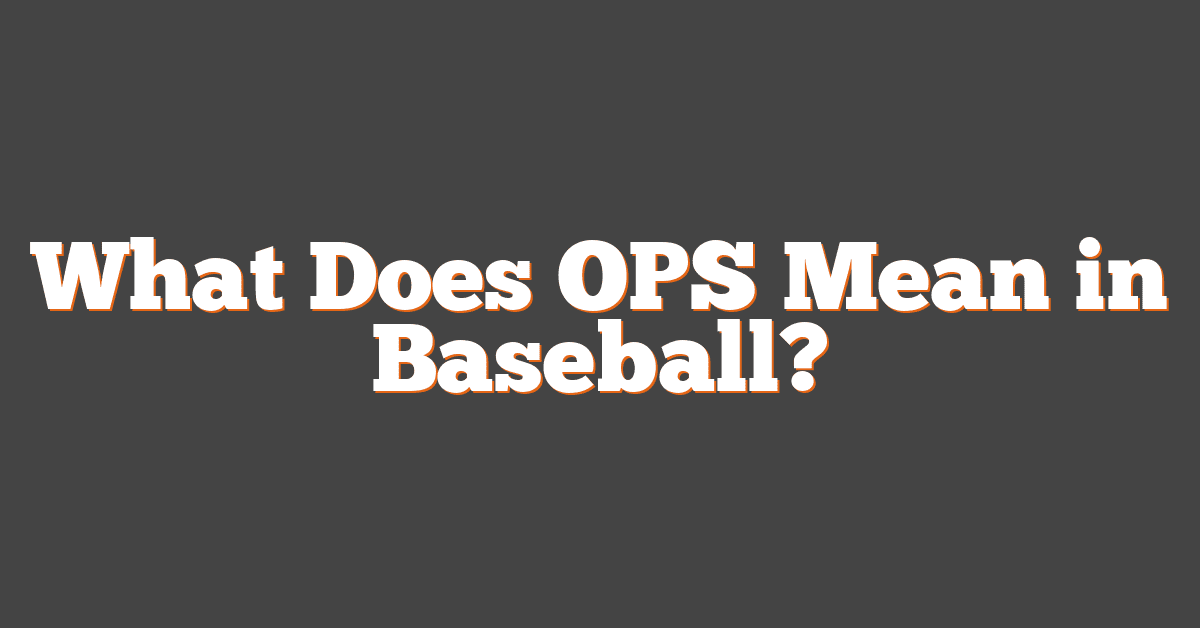If you’re a baseball fan, you’ve probably heard someone use the term OPS before. But what does it actually mean?
In baseball, OPS is a statistical measure that combines a player’s on-base percentage and slugging percentage. The acronym stands for “on-base plus slugging.”
OPS is used to measure a player’s overall offensive contribution. It’s often used as a shorthand to compare players at different positions or with different skill sets.
Generally speaking, the higher a player’s OPS, the better they are on the offensive. However, it’s important to remember that OPS is just one tool of many when it comes to evaluating players. Other factors, such as defensive ability and base running, need to be considered as well.
Why Calculate OPS in Baseball?
As we mentioned before, OPS is a quick way to measure a player’s overall offensive contribution. It takes into account both a player’s ability to get on base (via hits, walks, etc.) and their power (measured by their extra-base hit totals).
So, why is this important? Well, as any baseball fan knows, offense is the name of the game. The team that scores the most runs usually wins, so having a good offensive team is vital to success.
OPS is a helpful metric because it condenses a lot of information into one number. When you’re looking at a player’s OPS, you can immediately get an idea of how good they are at producing runs. And as we all know, runs equal wins.
So, if you’re looking to evaluate a player’s offensive contribution, OPS is a good place to start. It’s not perfect, but it’s a quick and easy way to get an idea of how good a hitter is. And in baseball, every little bit helps.
How to Increase OPS in Baseball?
One of the most important things a baseball team can do to increase its OPS is to focus on getting more hits. This means that hitters need to be more aggressive at the plate and try to make contact with the ball more often. They should also look for ways to get on base, such as by taking walks or hitting singles.
Another way to increase OPS is by hitting for more power. This means that hitters should try to hit the ball hard and drive it into the gaps in the defense. Power hitters typically have higher OPS numbers than players who simply focus on getting on base.
Finally, teams can increase their OPS by increasing the number of runs they score. This can be done by either hitting more home runs or by manufacturing runs with small ball strategies like bunting and stealing bases.
By following these tips, teams can increase their OPS and give themselves a better chance of winning games.
Why Is OPS a Helpful Metric in Baseball?
OPS, or on-base plus slugging, is a baseball metric that combines a player’s on-base percentage and their slugging percentage. Theoretically, it’s supposed to measure a player’s overall offensive ability.
OPS is generally considered to be a helpful metric when evaluating baseball players, as it gives a more well-rounded view of a player’s offensive skills. Additionally, OPS can be used to compare players across different positions – something that can be difficult to do with other measures such as batting average or home runs.
One potential downside of using OPS as a metric is that it puts more emphasis on power hitting than other aspects of offense, such as getting on base or stealing bases. However, overall, OPS is still a helpful tool for evaluating baseball players.
What Is a Good OPS in Baseball?
A good OPS in baseball can be defined as a player’s on-base percentage plus their slugging percentage. The average OPS in baseball is typically around .700, so a player with an OPS above that is considered to be above average. A player with an OPS below .700 is considered to be below average. There are a number of different ways to calculate a player’s OPS, but the most common way is to simply add their on-base percentage and their slugging percentage together.
There are a number of factors that can affect a player’s OPS. One of the biggest factors is whether or not they hit for power. A player who hits for a lot of power will typically have a higher OPS than a player who doesn’t hit for much power. Additionally, a player’s on-base percentage can be affected by their ability to draw walks. Players who are able to draw a lot of walks will typically have a higher on-base percentage than players who don’t draw many walks.
OPS is just one of the many statistics that baseball analysts use to evaluate players. However, it is an important stat because it provides a good measure of a player’s overall offensive production. Additionally, OPS is often used as a tiebreaker when comparing two players with similar statistics.
There are a few different ways to calculate OPS. The most common way is to simply add a player’s on-base percentage and their slugging percentage together. However, there are other ways to calculate OPS that weigh each component differently.
OPS is a good measure of a player’s overall offensive production, but it is just one of many statistics that baseball analysts use to evaluate players. Additionally, OPS is often used as a tiebreaker when comparing two players with similar statistics.
Our Final Thoughts
So, there you have it, our complete analysis and thoughts on what OPS means in baseball and why it is an important metric. Every baseball player worth their salt needs to look at their OPS if they want to make a good impression on their coach and have grander ambitions of playing in the big leagues. That’s because it is by calculating the OPS of a player that you find out how good their statistics are in reality.

